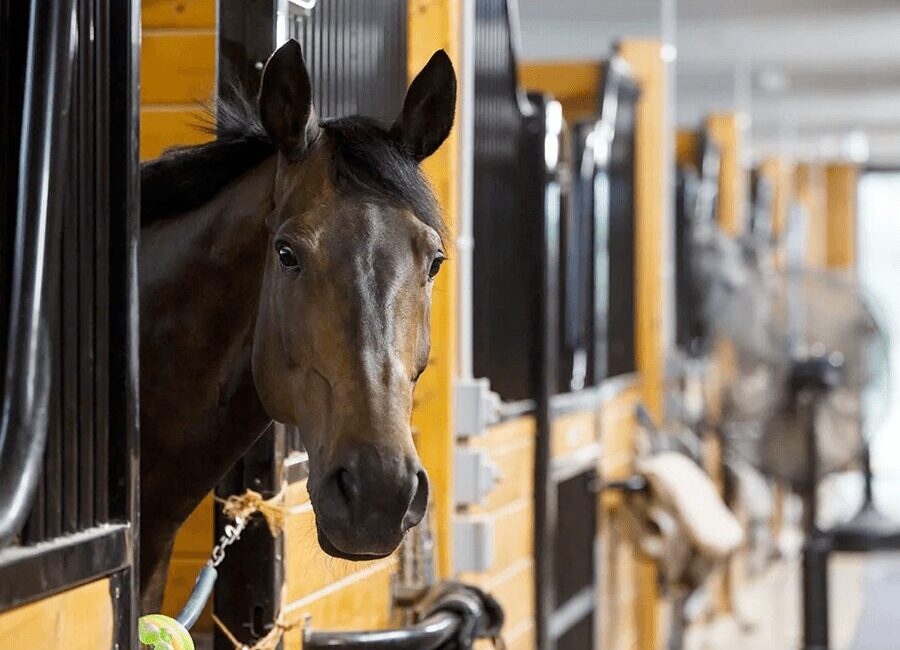Tuesday, March 19 is the first day of spring and the topic of “spring cleaning” will likely be in surround-sound mode.
For horse owners, it’s a great time to think about what a truly “clean” horse environment means in the context of our horses’ health. Horses don’t really care about neatly raked aisles or meticulously organized tack rooms, but clean air will go a long way in their overall health.
Clean Air
Clean air is critical to horse’s health, happiness and performance. But it’s challenging to maintain in the equine environment, especially in the horse’s breathing zone.
Our horses’ lungs function as air filters. But the stabled environment is loaded with microscopic particles that can clog those filters.
Even before these bits of mold, mites and various allergens – aka “respirable dust” — get into the lungs, they can settle in the lining of the upper respiratory tract. There, they cause irritation that triggers mucus and inflammation. And that restricts the flow of oxygen in and out. Hence the name Inflammatory Airway Disease, for conditions on the mild and moderate end of the Equine Asthma Spectrum.
It’s a spectrum we don’t want our horse on.
Living outdoors is ideal for equine respiratory health. (Unless, of course, there’s extreme air pollution or wildfire smoke increasing particulate matter in the area.) But outdoor living is not a full-time reality for most horses, Many spend the majority of their day stabled inside.
Living in a stall, horses are exposed to the two biggest sources of dangerous dust – bedding and hay. These have a double whammy effect because hay is often fed on the stall floor, so the horse spends much of its day with its nose in the area that has the highest concentrations of dust particles. The nostrils are the entry to the respiratory tract, so this is not good for respiratory health.

While commercially produced ammonia is often used in spring cleaning tasks, urine-related ammonia concentration is another invisible threat to horse’s respiratory health.
It’s a major irritant that triggers inflammation. If we can smell ammonia, it’s already at a level that can be harmful to horses and humans.
Better Bedding
A stall bedded deeply with fresh, aromatic wood shavings may look like an ideal, clean environment. In reality, wood shavings can be loaded with respirable dust particles, fungi and bacteria — all of which are associated with respiratory disease.
Traditional wood bedding does a poor job of absorbing ammonia and straw bedding is even worse.
This study conducted by the University of Delaware, in conjunction with the University of Florida, shows how shavings and straw contribute to unhealthy air quality.
Bedding made of cardboard improves stable air quality and Airlite stands out in this category. It’s virtually zero-dust. It’s made of pre-consumer cardboard, so it has no contaminants. Airlite is up to 5X as absorbent as wood shavings and it neutralizes ammonia.
Plus, it’s ideal for composting, helping horse keepers reduce our environmental hoofprint the planet.
Better Hay
Hay is a double edge sword when it comes to horse health. It’s ideal as the main source of their needed nutrients, but even great looking hay can be loaded with respirable particles. Steaming hay in commercial equipment proven to reduce particles is the best way to feed hay that won’t pose a risk to respiratory health.
Soaking hay will dampen down the dust, making it less likely to be inhaled. But soaking can increase bacteria and mold content, so it has its drawbacks.
Better Cleaning Practices

COVID in the human world, and EHV-1, strangles and other diseases in the horse world, have heighted awareness of how easily diseases are spread and how important it is to prevent that.
Using an effective disinfectant in daily and deep cleaning practices is the best line of defense against contagious diseases.
Traditional disinfectants like bleach, hydrogen peroxide and those classified as “quaternary” or “quats” all have serious downsides. Corrosive, irritating, allergenic – even toxic – are some of those negatives.
An effective, plant-based product is perfect for the stables. In the past, botanical disinfectants have not been as effective as their chemical-based counterparts. A thyme-based product, Thymox, is changing that.
Registered with the Environmental Protection Agency, Thymox is proven to kill 99.9% of the viruses and bacteria that cause EHV-1, strangles, influenza and other diseases, plus COVID-19 and mold and fungi. Yet it’s safe and easy to use on any surface.
Tack, feed and water buckets, and brushes should be on the long list of things to clean and disinfect. The list includes anything that our horse’s nose and mouth come into contact with.
Before a new horse comes into a stall, the walls, floor, water troughs, feed holders, etc., should get a thorough disinfecting. Thorough means ensuring that the entire surface is covered by the disinfectant.
Choosing a product that’s effective on contact and safe enough to leave on after application makes this potentially time intensive task relatively easy and fast.





